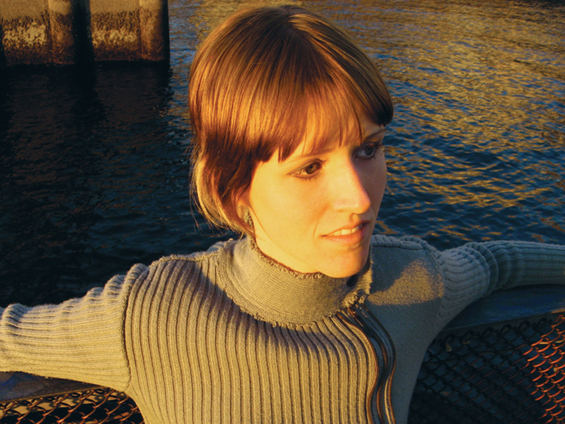

KATE SIMKO'S TOP TEN WOMEN COMPOSERS
With the concurrent release of her Spectral Sound debut She Said and two new Death is Nothing to Fear EPs on which she appears, Kate Simko's musical profile is clearly in the ascendant. The Chicago-based producer and DJ brings a wealth of formal training to her left-field house and techno productions: having grown up studying piano and music theory, she shifted her academic focus from a degree in classical piano to electronic music composition and continued her studies following a 2001 move to Santiago, Chile. The move was doubly fortuitous as a meeting with Andres Bucci developed into a subsequent partnership under the name Detalles (full-lengths have appeared on Traum and Kupei Musika). Despite an ever-intensifying schedule of performance dates and creative projects, Simko generously found time to compose a provocative list for textura.
(Organized in chronological order of recommended record release year)
1. Nina Simone
Composing over 500 songs and recording almost 60 albums, Nina Simone must be one of the most prolific women artists in history. A classically trained pianist, Simone honed her talents at a young age and attended the Julliard School of Music for her final year of high school. Simone described her music as “black classical music” rather than jazz. Her lush orchestrations, delicate piano playing, and challenging lyrical themes have left a legacy.
Recommended: I Put a Spell on You (LP, 1965)
2. Dorothy Ashby
Considered to be one of the best jazz harpists of all time, Detroit-based Dorothy Ashby is another classically trained, virtuosic musician. Growing up with a jazz guitarist father, Ashby started playing back-up piano during her father's sessions. After trying out saxophone and upright bass in high school, Ashby went on to study piano and music education at Wayne State University . In time she made the switch to a professional harp player, showing doubting jazz ensembles that a typically classical instrument could be played in the most funky, improvisational way.
Recommended: Afro Harping (Cadet Records, 1968)
3. Alice Coltrane
One of the rare female instrumentalists in jazz, Alice Coltrane was also (along with Dorothy Ashby) one of the few harpists in jazz. After marrying John Coltrane in 1965, Alice replaced McCoy Tyner as the Coltrane group's pianist in 1966. However, at the same time, Alice pursued her own musical voice, creating her own compositions with herself on piano, organ, harp, and later, Indian instruments such as the tamboura. Her later recordings are known for their lush, Stravinsky-esque orchestrations and psychedelic, spiritual vibe.
Recommended: Ptah The El Daoud (Impulse, 1970)
4. Laurie Anderson
Known for her avant-garde performance art pieces, Anderson 's breakout art rock song “O Superman” reached number two on the British pop charts after John Peel started DJing the record on the radio in 1980. Since then Anderson has composed music for film, dance, and theater and is recognized as a major contributor to the use of technology in the arts.
Recommended: O Superman (Warner Brothers, 1981)
5. Meredith Monk
A composer, singer, director/choreographer and creator of new opera, music theater works, films, and installations, Monk is also from the more experimental, performance art side of things. Monk's experimental vocal innovations have pushed the boundaries of using the voice as an instrument.
Recommended: Do You Be (ECM New Series, 1987)
6. Sade
Sade Adu was born in Nigeria but spent most of her life growing up in London . A singer-songwriter, composer, and record producer, she grew up listening to soul artists like Curtis Mayfield, Donny Hathaway, and Marvin Gaye. Their influence on her soulful vocal style is obvious.
Recommended: Stronger Than Pride (Epic, 1988)
7. Pauline Oliveros
A pioneer of electronic art music, Pauline Oliveros is best known for her experimental accordion and electronics recordings in resonant spaces such as caves, cathedrals, and large underground cisterns. Oliveros, along with Morton Subotnick and Ramon Sender, formed the San Francisco Tape Music Center in the early 1960s. Maintaining her presence in the academic world, Oliveros went on to create her own unique compositional theories and start the Center for Contemporary Music at Mills College, where she currently teaches composition.
Recommended: Deep Listening (New Albion, 1989)
8. Rachel Portman
British composer Rachel Portman, known for her lush movie scores, was the first female composer to win an Academy Award (for Emma in 1996). Her other works include scores for Cider House Rules, Chocolat, Addicted to Love, Beloved, The Joy Luck Club, and Benny and Joon.
Recommended: The Joy Luck Club (Hollywood Records, 1993)
9. Juana Molina
Formerly a famous comedic television actress in Argentina, Molina made the transition into producing her own music in the mid-‘90s. Molina's tango-singing father began teaching her guitar at the age of five. Combining acoustic guitar with electronics, Molina creates her own breed of experimental Argentine folk music.
Recommended: Segundo (Domino, 2003)
10. Joanna Newsom
A San Francisco-based harpist, pianist, harpsichordist, and singer, Newsom studied music composition and creative writing at Mills College in Oakland. Newsom incorporates elements from Appalachian music, avant-garde psych folk music, and West African kora rhythms into her wistful, childlike songs.
Recommended: The Milk Eyed Mender (Drag City, 2004)
April 2008
![]()